coolant level NISSAN QASHQAI 2017 Owner´s Manual
[x] Cancel search | Manufacturer: NISSAN, Model Year: 2017, Model line: QASHQAI, Model: NISSAN QASHQAI 2017Pages: 508, PDF Size: 2.68 MB
Page 87 of 508
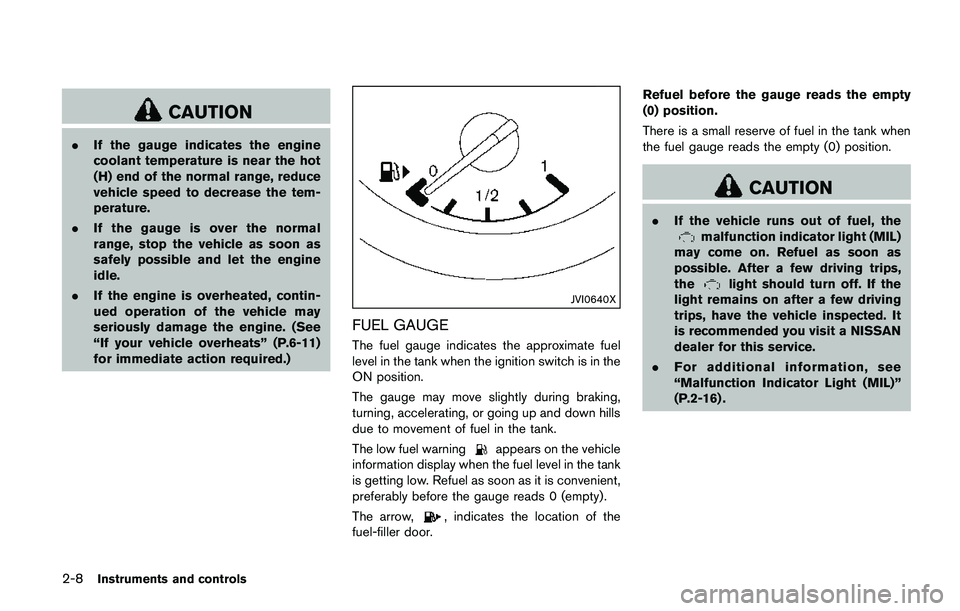
2-8Instruments and controls
CAUTION
.If the gauge indicates the engine
coolant temperature is near the hot
(H) end of the normal range, reduce
vehicle speed to decrease the tem-
perature.
.If the gauge is over the normal
range, stop the vehicle as soon as
safely possible and let the engine
idle.
.If the engine is overheated, contin-
ued operation of the vehicle may
seriously damage the engine. (See
“If your vehicle overheats” (P.6-11)
for immediate action required.)
JVI0640X
FUEL GAUGE
The fuel gauge indicates the approximate fuel
level in the tank when the ignition switch is in the
ON position.
The gauge may move slightly during braking,
turning, accelerating, or going up and down hills
due to movement of fuel in the tank.
The low fuel warning
appears on the vehicle
information display when the fuel level in the tank
is getting low. Refuel as soon as it is convenient,
preferably before the gauge reads 0 (empty) .
The arrow,
, indicates the location of the
fuel-filler door.Refuel before the gauge reads the empty
(0) position.
There is a small reserve of fuel in the tank when
the fuel gauge reads the empty (0) position.
CAUTION
.If the vehicle runs out of fuel, themalfunction indicator light (MIL)
may come on. Refuel as soon as
possible. After a few driving trips,
the
light should turn off. If the
light remains on after a few driving
trips, have the vehicle inspected. It
is recommended you visit a NISSAN
dealer for this service.
.For additional information, see
“Malfunction Indicator Light (MIL)”
(P.2-16) .
Page 409 of 508
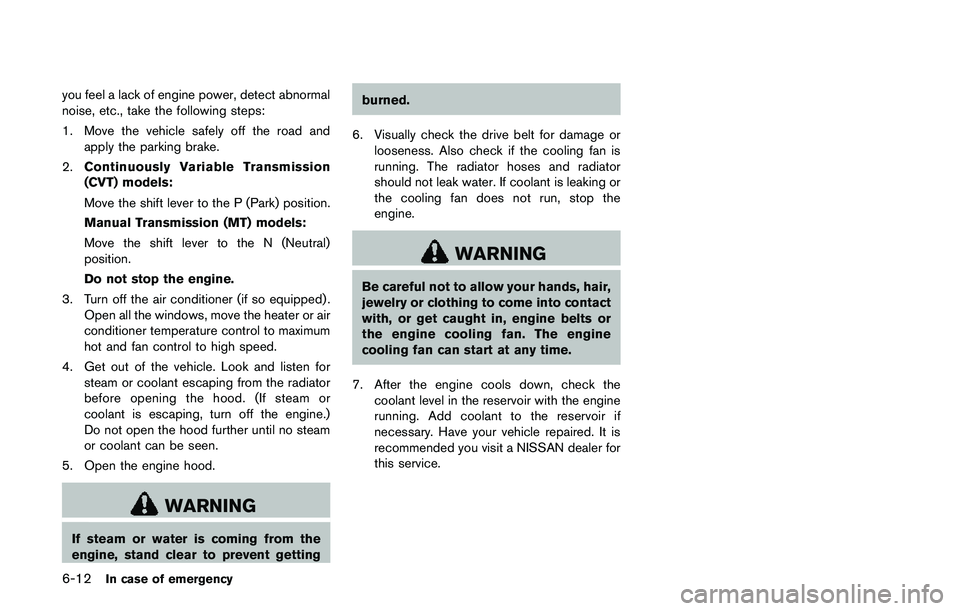
6-12In case of emergency
you feel a lack of engine power, detect abnormal
noise, etc., take the following steps:
1. Move the vehicle safely off the road and
apply the parking brake.
2.Continuously Variable Transmission
(CVT) models:
Move the shift lever to the P (Park) position.
Manual Transmission (MT) models:
Move the shift lever to the N (Neutral)
position.
Do not stop the engine.
3. Turn off the air conditioner (if so equipped) .
Open all the windows, move the heater or air
conditioner temperature control to maximum
hot and fan control to high speed.
4. Get out of the vehicle. Look and listen for
steam or coolant escaping from the radiator
before opening the hood. (If steam or
coolant is escaping, turn off the engine.)
Do not open the hood further until no steam
or coolant can be seen.
5. Open the engine hood.
WARNING
If steam or water is coming from the
engine, stand clear to prevent gettingburned.
6. Visually check the drive belt for damage or
looseness. Also check if the cooling fan is
running. The radiator hoses and radiator
should not leak water. If coolant is leaking or
the cooling fan does not run, stop the
engine.
WARNING
Be careful not to allow your hands, hair,
jewelry or clothing to come into contact
with, or get caught in, engine belts or
the engine cooling fan. The engine
cooling fan can start at any time.
7. After the engine cools down, check the
coolant level in the reservoir with the engine
running. Add coolant to the reservoir if
necessary. Have your vehicle repaired. It is
recommended you visit a NISSAN dealer for
this service.
Page 424 of 508
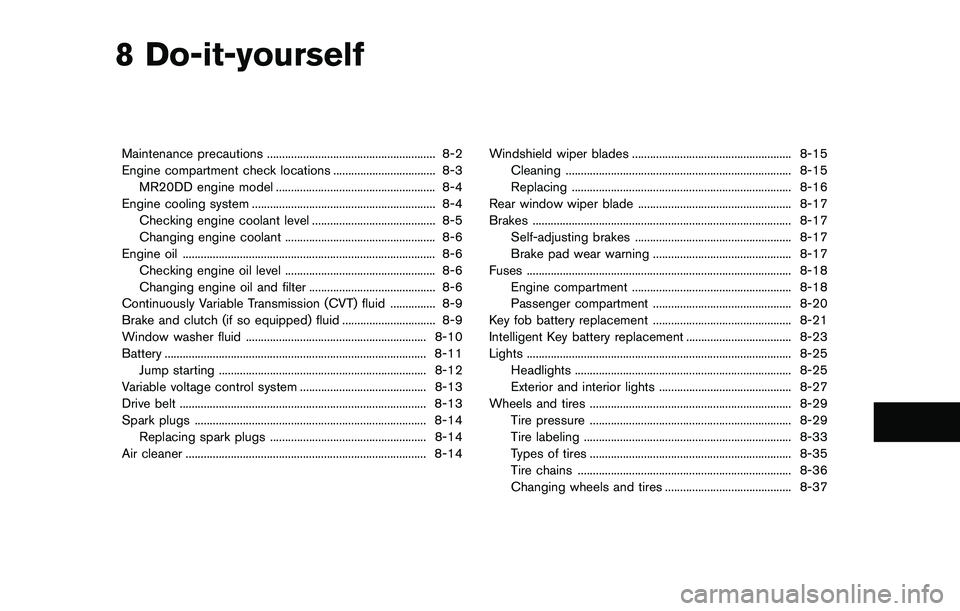
8 Do-it-yourself
Maintenance precautions ........................................................ 8-2
Engine compartment check locations .................................. 8-3
MR20DD engine model ..................................................... 8-4
Engine cooling system ............................................................. 8-4
Checking engine coolant level ......................................... 8-5
Changing engine coolant .................................................. 8-6
Engine oil .................................................................................... 8-6
Checking engine oil level .................................................. 8-6
Changing engine oil and filter .......................................... 8-6
Continuously Variable Transmission (CVT) fluid ............... 8-9
Brake and clutch (if so equipped) fluid ............................... 8-9
Window washer fluid ............................................................ 8-10
Battery ....................................................................................... 8-11
Jump starting ..................................................................... 8-12
Variable voltage control system .......................................... 8-13
Drive belt .................................................................................. 8-13
Spark plugs ............................................................................. 8-14
Replacing spark plugs .................................................... 8-14
Air cleaner ................................................................................ 8-14Windshield wiper blades ..................................................... 8-15
Cleaning ........................................................................... 8-15
Replacing ......................................................................... 8-16
Rear window wiper blade ................................................... 8-17
Brakes ...................................................................................... 8-17
Self-adjusting brakes .................................................... 8-17
Brake pad wear warning .............................................. 8-17
Fuses ........................................................................................ 8-18
Engine compartment ..................................................... 8-18
Passenger compartment .............................................. 8-20
Key fob battery replacement .............................................. 8-21
Intelligent Key battery replacement ................................... 8-23
Lights ........................................................................................ 8-25
Headlights ........................................................................ 8-25
Exterior and interior lights ............................................ 8-27
Wheels and tires ................................................................... 8-29
Tire pressure ................................................................... 8-29
Tire labeling ..................................................................... 8-33
Types of tires ................................................................... 8-35
Tire chains ....................................................................... 8-36
Changing wheels and tires .......................................... 8-37
Page 425 of 508
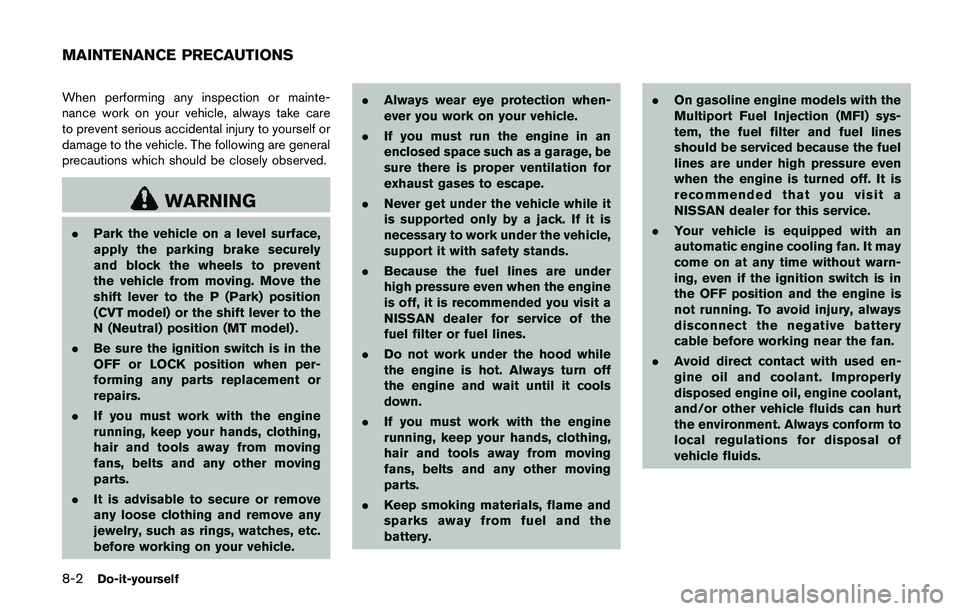
8-2Do-it-yourself
When performing any inspection or mainte-
nance work on your vehicle, always take care
to prevent serious accidental injury to yourself or
damage to the vehicle. The following are general
precautions which should be closely observed.
WARNING
.Park the vehicle on a level surface,
apply the parking brake securely
and block the wheels to prevent
the vehicle from moving. Move the
shift lever to the P (Park) position
(CVT model) or the shift lever to the
N (Neutral) position (MT model) .
.Be sure the ignition switch is in the
OFF or LOCK position when per-
forming any parts replacement or
repairs.
.If you must work with the engine
running, keep your hands, clothing,
hair and tools away from moving
fans, belts and any other moving
parts.
.It is advisable to secure or remove
any loose clothing and remove any
jewelry, such as rings, watches, etc.
before working on your vehicle..Always wear eye protection when-
ever you work on your vehicle.
.If you must run the engine in an
enclosed space such as a garage, be
sure there is proper ventilation for
exhaust gases to escape.
.Never get under the vehicle while it
is supported only by a jack. If it is
necessary to work under the vehicle,
support it with safety stands.
.Because the fuel lines are under
high pressure even when the engine
is off, it is recommended you visit a
NISSAN dealer for service of the
fuel filter or fuel lines.
.Do not work under the hood while
the engine is hot. Always turn off
the engine and wait until it cools
down.
.If you must work with the engine
running, keep your hands, clothing,
hair and tools away from moving
fans, belts and any other moving
parts.
.Keep smoking materials, flame and
sparks away from fuel and the
battery..On gasoline engine models with the
Multiport Fuel Injection (MFI) sys-
tem, the fuel filter and fuel lines
should be serviced because the fuel
lines are under high pressure even
when the engine is turned off. It is
recommended that you visit a
NISSAN dealer for this service.
.Your vehicle is equipped with an
automatic engine cooling fan. It may
come on at any time without warn-
ing, even if the ignition switch is in
the OFF position and the engine is
not running. To avoid injury, always
disconnect the negative battery
cable before working near the fan.
.Avoid direct contact with used en-
gine oil and coolant. Improperly
disposed engine oil, engine coolant,
and/or other vehicle fluids can hurt
the environment. Always conform to
local regulations for disposal of
vehicle fluids.
MAINTENANCE PRECAUTIONS
Page 428 of 508
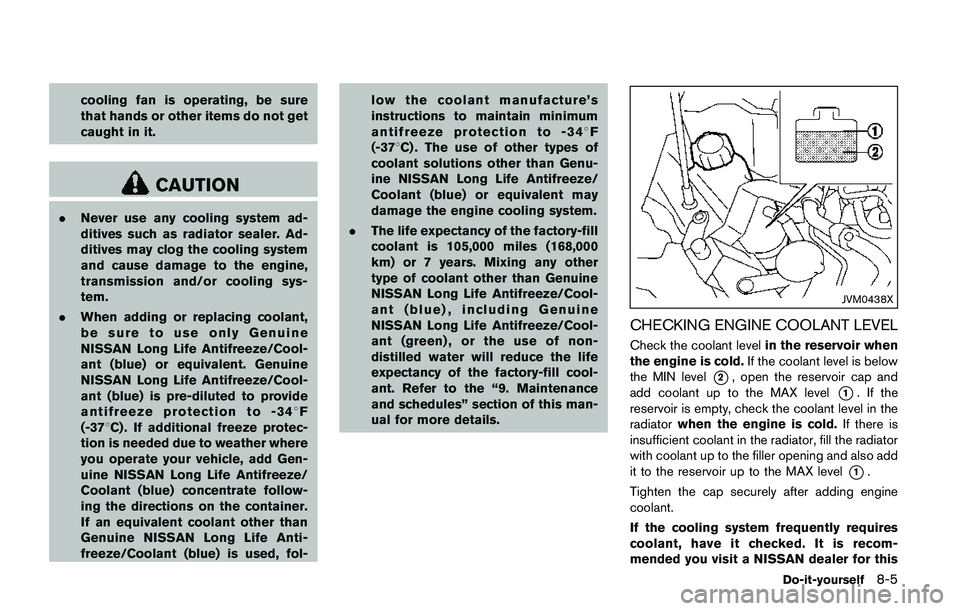
cooling fan is operating, be sure
that hands or other items do not get
caught in it.
CAUTION
.Never use any cooling system ad-
ditives such as radiator sealer. Ad-
ditives may clog the cooling system
and cause damage to the engine,
transmission and/or cooling sys-
tem.
.When adding or replacing coolant,
be sure to use only Genuine
NISSAN Long Life Antifreeze/Cool-
ant (blue) or equivalent. Genuine
NISSAN Long Life Antifreeze/Cool-
ant (blue) is pre-diluted to provide
antifreeze protection to -348F
(-378C) . If additional freeze protec-
tion is needed due to weather where
you operate your vehicle, add Gen-
uine NISSAN Long Life Antifreeze/
Coolant (blue) concentrate follow-
ing the directions on the container.
If an equivalent coolant other than
Genuine NISSAN Long Life Anti-
freeze/Coolant (blue) is used, fol-low the coolant manufacture’s
instructions to maintain minimum
antifreeze protection to -348F
(-378C) . The use of other types of
coolant solutions other than Genu-
ine NISSAN Long Life Antifreeze/
Coolant (blue) or equivalent may
damage the engine cooling system.
.The life expectancy of the factory-fill
coolant is 105,000 miles (168,000
km) or 7 years. Mixing any other
type of coolant other than Genuine
NISSAN Long Life Antifreeze/Cool-
ant (blue) , including Genuine
NISSAN Long Life Antifreeze/Cool-
ant (green) , or the use of non-
distilled water will reduce the life
expectancy of the factory-fill cool-
ant. Refer to the “9. Maintenance
and schedules” section of this man-
ual for more details.
JVM0438X
CHECKING ENGINE COOLANT LEVEL
Check the coolant levelin the reservoir when
the engine is cold.If the coolant level is below
the MIN level
*2, open the reservoir cap and
add coolant up to the MAX level
*1. If the
reservoir is empty, check the coolant level in the
radiatorwhen the engine is cold.If there is
insufficient coolant in the radiator, fill the radiator
with coolant up to the filler opening and also add
it to the reservoir up to the MAX level
*1.
Tighten the cap securely after adding engine
coolant.
If the cooling system frequently requires
coolant, have it checked. It is recom-
mended you visit a NISSAN dealer for this
Do-it-yourself8-5
Page 429 of 508
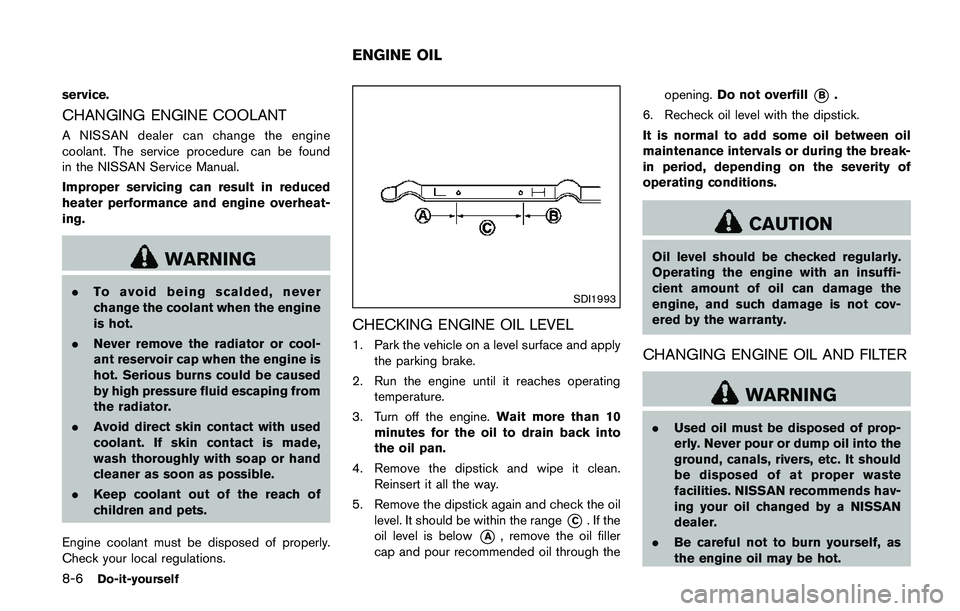
8-6Do-it-yourself
service.
CHANGING ENGINE COOLANT
A NISSAN dealer can change the engine
coolant. The service procedure can be found
in the NISSAN Service Manual.
Improper servicing can result in reduced
heater performance and engine overheat-
ing.
WARNING
.To avoid being scalded, never
change the coolant when the engine
is hot.
.Never remove the radiator or cool-
ant reservoir cap when the engine is
hot. Serious burns could be caused
by high pressure fluid escaping from
the radiator.
.Avoid direct skin contact with used
coolant. If skin contact is made,
wash thoroughly with soap or hand
cleaner as soon as possible.
.Keep coolant out of the reach of
children and pets.
Engine coolant must be disposed of properly.
Check your local regulations.SDI1993
CHECKING ENGINE OIL LEVEL
1. Park the vehicle on a level surface and apply
the parking brake.
2. Run the engine until it reaches operating
temperature.
3. Turn off the engine.Wait more than 10
minutes for the oil to drain back into
the oil pan.
4. Remove the dipstick and wipe it clean.
Reinsert it all the way.
5. Remove the dipstick again and check the oil
level. It should be within the range
*C. If the
oil level is below
*A, remove the oil filler
cap and pour recommended oil through theopening.Do not overfill
*B.
6. Recheck oil level with the dipstick.
It is normal to add some oil between oil
maintenance intervals or during the break-
in period, depending on the severity of
operating conditions.
CAUTION
Oil level should be checked regularly.
Operating the engine with an insuffi-
cient amount of oil can damage the
engine, and such damage is not cov-
ered by the warranty.
CHANGING ENGINE OIL AND FILTER
WARNING
.Used oil must be disposed of prop-
erly. Never pour or dump oil into the
ground, canals, rivers, etc. It should
be disposed of at proper waste
facilities. NISSAN recommends hav-
ing your oil changed by a NISSAN
dealer.
.Be careful not to burn yourself, as
the engine oil may be hot.
ENGINE OIL
Page 433 of 508
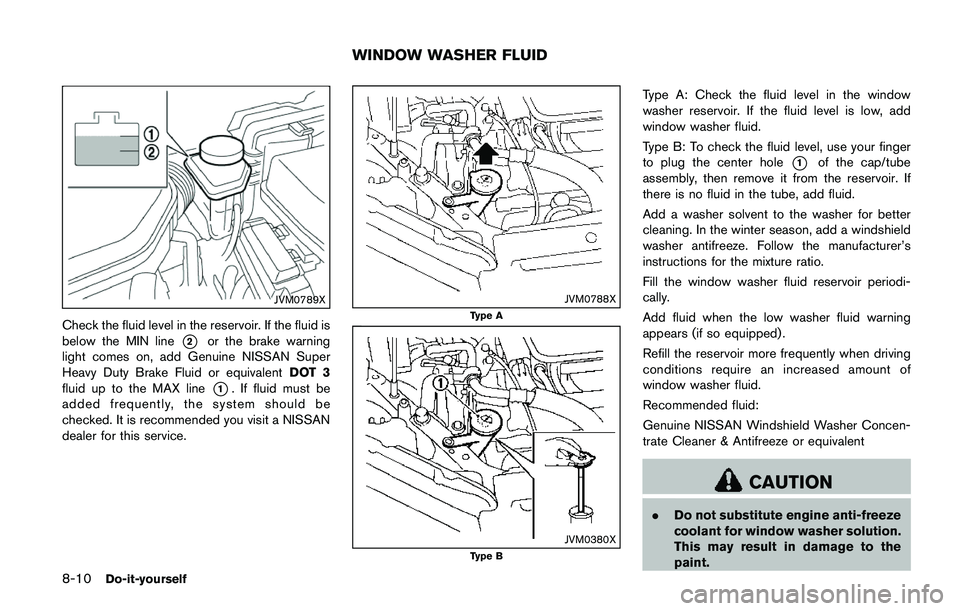
8-10Do-it-yourself
JVM0789X
Check the fluid level in the reservoir. If the fluid is
below the MIN line
*2or the brake warning
light comes on, add Genuine NISSAN Super
Heavy Duty Brake Fluid or equivalentDOT 3
fluid up to the MAX line
*1. If fluid must be
added frequently, the system should be
checked. It is recommended you visit a NISSAN
dealer for this service.
JVM0788X
Type A
JVM0380XType B
Type A: Check the fluid level in the window
washer reservoir. If the fluid level is low, add
window washer fluid.
Type B: To check the fluid level, use your finger
to plug the center hole
*1of the cap/tube
assembly, then remove it from the reservoir. If
there is no fluid in the tube, add fluid.
Add a washer solvent to the washer for better
cleaning. In the winter season, add a windshield
washer antifreeze. Follow the manufacturer’s
instructions for the mixture ratio.
Fill the window washer fluid reservoir periodi-
cally.
Add fluid when the low washer fluid warning
appears (if so equipped) .
Refill the reservoir more frequently when driving
conditions require an increased amount of
window washer fluid.
Recommended fluid:
Genuine NISSAN Windshield Washer Concen-
trate Cleaner & Antifreeze or equivalent
CAUTION
.Do not substitute engine anti-freeze
coolant for window washer solution.
This may result in damage to the
paint.
WINDOW WASHER FLUID
Page 467 of 508
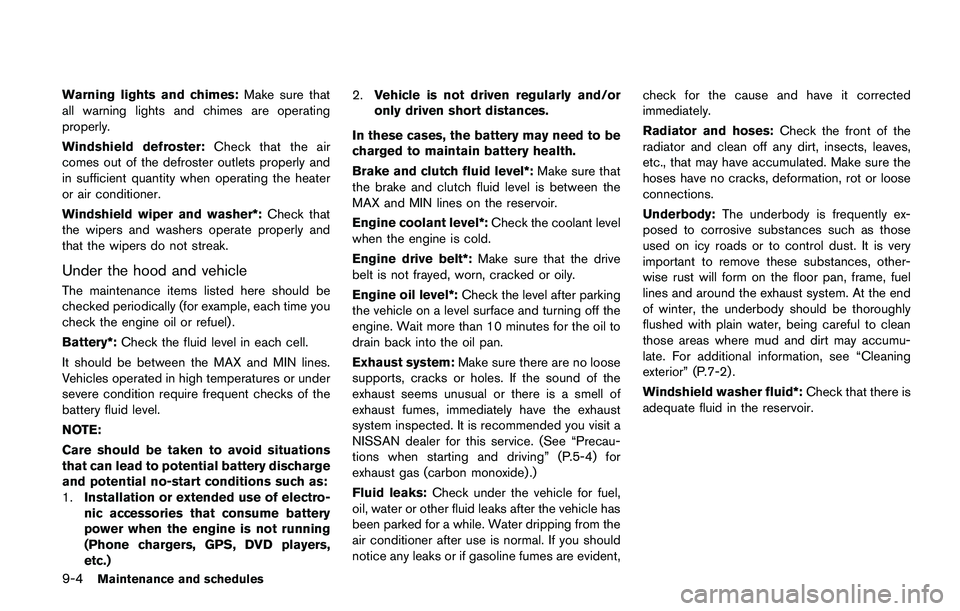
9-4Maintenance and schedules
Warning lights and chimes:Make sure that
all warning lights and chimes are operating
properly.
Windshield defroster:Check that the air
comes out of the defroster outlets properly and
in sufficient quantity when operating the heater
or air conditioner.
Windshield wiper and washer*:Check that
the wipers and washers operate properly and
that the wipers do not streak.
Under the hood and vehicle
The maintenance items listed here should be
checked periodically (for example, each time you
check the engine oil or refuel) .
Battery*:Check the fluid level in each cell.
It should be between the MAX and MIN lines.
Vehicles operated in high temperatures or under
severe condition require frequent checks of the
battery fluid level.
NOTE:
Care should be taken to avoid situations
that can lead to potential battery discharge
and potential no-start conditions such as:
1.Installation or extended use of electro-
nic accessories that consume battery
power when the engine is not running
(Phone chargers, GPS, DVD players,
etc.)2.Vehicle is not driven regularly and/or
only driven short distances.
In these cases, the battery may need to be
charged to maintain battery health.
Brake and clutch fluid level*:Make sure that
the brake and clutch fluid level is between the
MAX and MIN lines on the reservoir.
Engine coolant level*:Check the coolant level
when the engine is cold.
Engine drive belt*:Make sure that the drive
belt is not frayed, worn, cracked or oily.
Engine oil level*:Check the level after parking
the vehicle on a level surface and turning off the
engine. Wait more than 10 minutes for the oil to
drain back into the oil pan.
Exhaust system:Make sure there are no loose
supports, cracks or holes. If the sound of the
exhaust seems unusual or there is a smell of
exhaust fumes, immediately have the exhaust
system inspected. It is recommended you visit a
NISSAN dealer for this service. (See “Precau-
tions when starting and driving” (P.5-4) for
exhaust gas (carbon monoxide) .)
Fluid leaks:Check under the vehicle for fuel,
oil, water or other fluid leaks after the vehicle has
been parked for a while. Water dripping from the
air conditioner after use is normal. If you should
notice any leaks or if gasoline fumes are evident,check for the cause and have it corrected
immediately.
Radiator and hoses:Check the front of the
radiator and clean off any dirt, insects, leaves,
etc., that may have accumulated. Make sure the
hoses have no cracks, deformation, rot or loose
connections.
Underbody:The underbody is frequently ex-
posed to corrosive substances such as those
used on icy roads or to control dust. It is very
important to remove these substances, other-
wise rust will form on the floor pan, frame, fuel
lines and around the exhaust system. At the end
of winter, the underbody should be thoroughly
flushed with plain water, being careful to clean
those areas where mud and dirt may accumu-
late. For additional information, see “Cleaning
exterior” (P.7-2) .
Windshield washer fluid*:Check that there is
adequate fluid in the reservoir.
Page 481 of 508
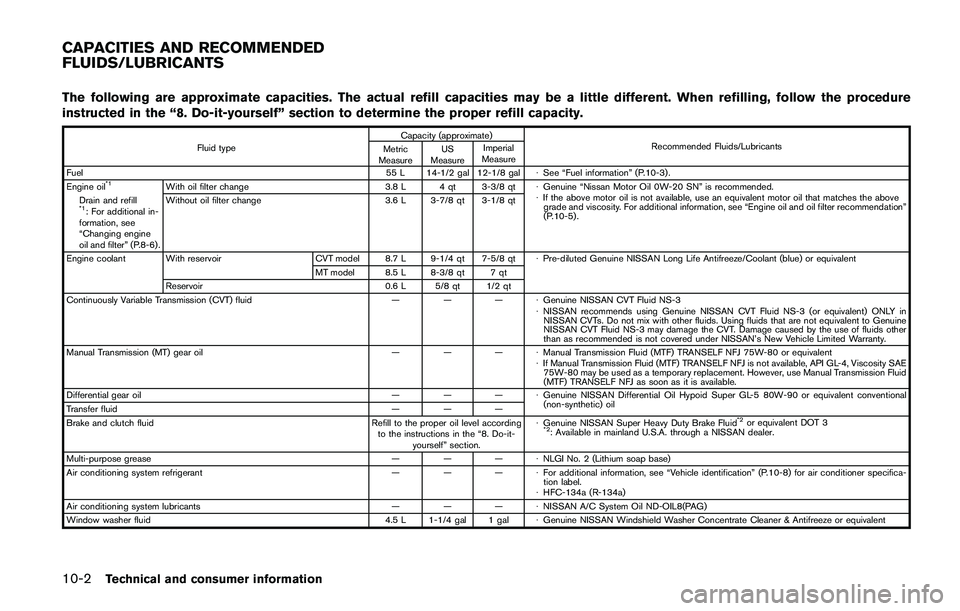
10-2Technical and consumer information
The following are approximate capacities. The actual refill capacities may be a little different. When refilling, follow the procedure
instructed in the “8. Do-it-yourself” section to determine the proper refill capacity.
Fluid typeCapacity (approximate)
Recommended Fluids/Lubricants
Metric
MeasureUS
MeasureImperial
Measure
Fuel55 L 14-1/2 gal 12-1/8 gal�ÂSee “Fuel information” (P.10-3).
Engine oil
*1With oil filter change 3.8 L 4 qt 3-3/8 qt�ÂGenuine “Nissan Motor Oil 0W-20 SN” is recommended.
�ÂIf the above motor oil is not available, use an equivalent motor oil that matches the above
grade and viscosity. For additional information, see “Engine oil and oil filter recommendation”
(P.10-5). Drain and refill
*1: For additional in-
formation, see
“Changing engine
oil and filter” (P.8-6).Without oil filter change 3.6 L 3-7/8 qt 3-1/8 qt
Engine coolant With reservoir CVT model 8.7 L 9-1/4 qt 7-5/8 qt�ÂPre-diluted Genuine NISSAN Long Life Antifreeze/Coolant (blue) or equivalent
MT model 8.5 L 8-3/8 qt 7 qt
Reservoir 0.6 L 5/8 qt 1/2 qt
Continuously Variable Transmission (CVT) fluid — — —�ÂGenuine NISSAN CVT Fluid NS-3
�ÂNISSAN recommends using Genuine NISSAN CVT Fluid NS-3 (or equivalent) ONLY in
NISSAN CVTs. Do not mix with other fluids. Using fluids that are not equivalent to Genuine
NISSAN CVT Fluid NS-3 may damage the CVT. Damage caused by the use of fluids other
than as recommended is not covered under NISSAN’s New Vehicle Limited Warranty.
Manual Transmission (MT) gear oil — — —�ÂManual Transmission Fluid (MTF) TRANSELF NFJ 75W-80 or equivalent
�ÂIf Manual Transmission Fluid (MTF) TRANSELF NFJ is not available, API GL-4, Viscosity SAE
75W-80 may be used as a temporary replacement. However, use Manual Transmission Fluid
(MTF) TRANSELF NFJ as soon as it is available.
Differential gear oil — — —�ÂGenuine NISSAN Differential Oil Hypoid Super GL-5 80W-90 or equivalent conventional
(non-synthetic) oil
Transfer fluid — — —
Brake and clutch fluid Refill to the proper oil level according
to the instructions in the “8. Do-it-
yourself” section.�ÂGenuine NISSAN Super Heavy Duty Brake Fluid
*2or equivalent DOT 3*2: Available in mainland U.S.A. through a NISSAN dealer.
Multi-purpose grease — — —�ÂNLGI No. 2 (Lithium soap base)
Air conditioning system refrigerant — — —�ÂFor additional information, see “Vehicle identification” (P.10-8) for air conditioner specifica-
tion label.
�ÂHFC-134a (R-134a)
Air conditioning system lubricants — — —�ÂNISSAN A/C System Oil ND-OIL8(PAG)
Window washer fluid 4.5 L 1-1/4 gal 1 gal�ÂGenuine NISSAN Windshield Washer Concentrate Cleaner & Antifreeze or equivalent
CAPACITIES AND RECOMMENDED
FLUIDS/LUBRICANTS
Page 501 of 508
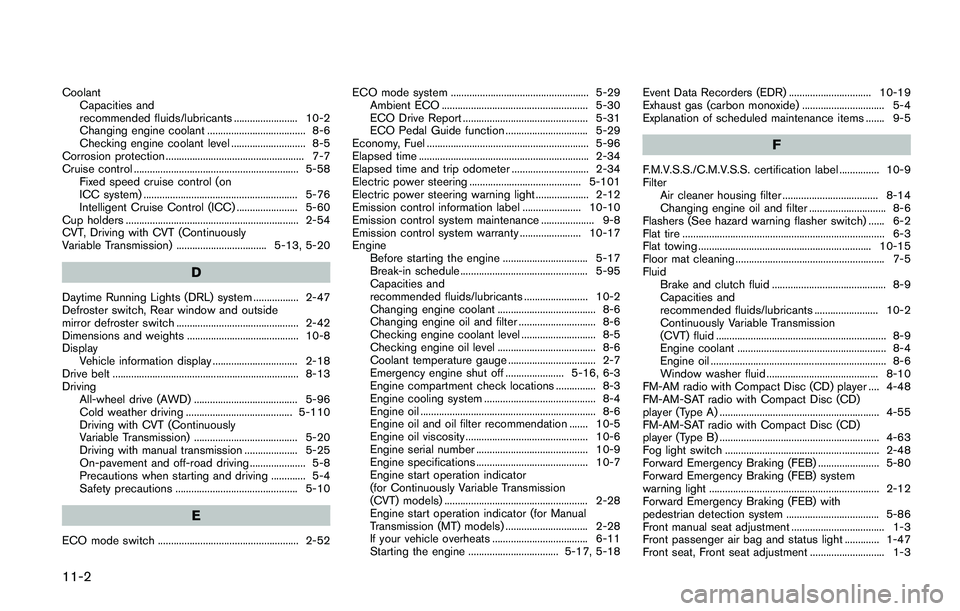
11-2
Coolant
Capacities and
recommended fluids/lubricants ........................ 10-2
Changing engine coolant ..................................... 8-6
Checking engine coolant level ............................ 8-5
Corrosion protection .................................................... 7-7
Cruise control .............................................................. 5-58
Fixed speed cruise control (on
ICC system) .......................................................... 5-76
Intelligent Cruise Control (ICC) ....................... 5-60
Cup holders ................................................................. 2-54
CVT, Driving with CVT (Continuously
Variable Transmission) .................................. 5-13, 5-20
D
Daytime Running Lights (DRL) system ................. 2-47
Defroster switch, Rear window and outside
mirror defroster switch .............................................. 2-42
Dimensions and weights .......................................... 10-8
Display
Vehicle information display ................................ 2-18
Drive belt ...................................................................... 8-13
Driving
All-wheel drive (AWD) ....................................... 5-96
Cold weather driving ........................................ 5-110
Driving with CVT (Continuously
Variable Transmission) ....................................... 5-20
Driving with manual transmission .................... 5-25
On-pavement and off-road driving ..................... 5-8
Precautions when starting and driving ............. 5-4
Safety precautions .............................................. 5-10
E
ECO mode switch ..................................................... 2-52ECO mode system .................................................... 5-29
Ambient ECO ....................................................... 5-30
ECO Drive Report ............................................... 5-31
ECO Pedal Guide function ............................... 5-29
Economy, Fuel ............................................................. 5-96
Elapsed time ................................................................ 2-34
Elapsed time and trip odometer ............................. 2-34
Electric power steering .......................................... 5-101
Electric power steering warning light .................... 2-12
Emission control information label ...................... 10-10
Emission control system maintenance .................... 9-8
Emission control system warranty ....................... 10-17
Engine
Before starting the engine ................................ 5-17
Break-in schedule ................................................ 5-95
Capacities and
recommended fluids/lubricants ........................ 10-2
Changing engine coolant ..................................... 8-6
Changing engine oil and filter ............................. 8-6
Checking engine coolant level ............................ 8-5
Checking engine oil level ..................................... 8-6
Coolant temperature gauge ................................. 2-7
Emergency engine shut off ...................... 5-16, 6-3
Engine compartment check locations ............... 8-3
Engine cooling system .......................................... 8-4
Engine oil .................................................................. 8-6
Engine oil and oil filter recommendation ....... 10-5
Engine oil viscosity .............................................. 10-6
Engine serial number .......................................... 10-9
Engine specifications .......................................... 10-7
Engine start operation indicator
(for Continuously Variable Transmission
(CVT) models) ...................................................... 2-28
Engine start operation indicator (for Manual
Transmission (MT) models) ............................... 2-28
If your vehicle overheats .................................... 6-11
Starting the engine .................................. 5-17, 5-18Event Data Recorders (EDR) ............................... 10-19
Exhaust gas (carbon monoxide) ............................... 5-4
Explanation of scheduled maintenance items ....... 9-5
F
F.M.V.S.S./C.M.V.S.S. certification label ............... 10-9
Filter
Air cleaner housing filter .................................... 8-14
Changing engine oil and filter ............................. 8-6
Flashers (See hazard warning flasher switch) ...... 6-2
Flat tire ............................................................................ 6-3
Flat towing ................................................................. 10-15
Floor mat cleaning ........................................................ 7-5
Fluid
Brake and clutch fluid ........................................... 8-9
Capacities and
recommended fluids/lubricants ........................ 10-2
Continuously Variable Transmission
(CVT) fluid ................................................................ 8-9
Engine coolant ........................................................ 8-4
Engine oil .................................................................. 8-6
Window washer fluid .......................................... 8-10
FM-AM radio with Compact Disc (CD) player .... 4-48
FM-AM-SAT radio with Compact Disc (CD)
player (Type A) ............................................................ 4-55
FM-AM-SAT radio with Compact Disc (CD)
player (Type B) ............................................................ 4-63
Fog light switch .......................................................... 2-48
Forward Emergency Braking (FEB) ....................... 5-80
Forward Emergency Braking (FEB) system
warning light ................................................................ 2-12
Forward Emergency Braking (FEB) with
pedestrian detection system ................................... 5-86
Front manual seat adjustment ................................... 1-3
Front passenger air bag and status light ............. 1-47
Front seat, Front seat adjustment ............................ 1-3